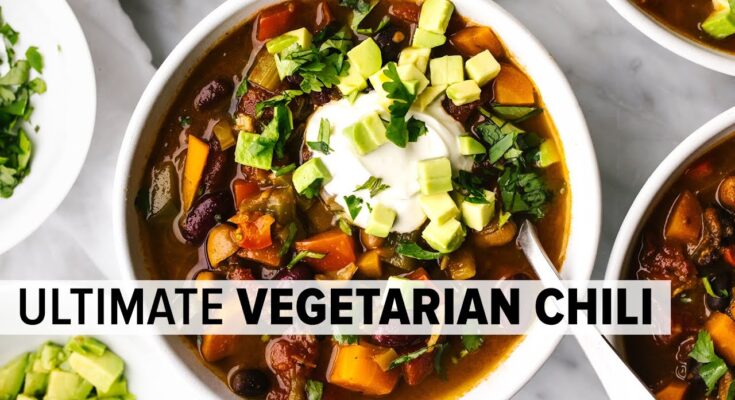Vegan Chili Recipe: Vegan chili is a hearty, flavorful, and protein-packed dish that’s perfect for any occasion. Whether you’re looking for a comforting meal on a cold day or a nutritious dinner packed with vegetables and plant-based protein, this recipe has you covered.
Why go vegan with chili? It’s not just about skipping the meat—vegan chili is a healthier, cruelty-free alternative that doesn’t compromise on flavor. Packed with fiber, vitamins, and antioxidants, this dish supports a balanced diet while satisfying your taste buds.
In this guide, you’ll learn how to create the perfect vegan chili step-by-step. From selecting the right ingredients to customizing flavors, you’ll be equipped to make a delicious bowl of chili that everyone will love.
Ingredients for Vegan Chili
Essential Ingredients
Before you start cooking, it’s important to gather the right ingredients. Here’s what you’ll need:
- Beans and Legumes: Black beans, kidney beans, and pinto beans add texture, protein, and fiber.
- Vegetables: Onions, garlic, bell peppers, carrots, and celery create the flavor base.
- Tomatoes: Crushed tomatoes and tomato paste add richness and depth.
- Spices and Seasonings: Chili powder, cumin, smoked paprika, oregano, and cayenne pepper give the chili its signature flavor.
- Broth or Water: Vegetable broth enhances the flavor while maintaining moisture.
Optional Add-ins and Variations
- Grains: Quinoa or bulgur wheat for extra bulk and texture.
- Plant-Based Meat Alternatives: Tofu, tempeh, or soy crumbles for a “meaty” feel.
- Sweetness and Tanginess: Corn, sweet potatoes, or a splash of lime juice for flavor balance.
- Greens: Spinach or kale can be stirred in at the end for added nutrients.
Now that you have your ingredients ready, let’s dive into the cooking process.
Step-by-Step Cooking Instructions
Step 1: Preparing Ingredients
Start by washing and chopping all your vegetables. Dice the onions, mince the garlic, and chop bell peppers, carrots, and celery into bite-sized pieces. Drain and rinse canned beans to remove excess sodium.
Tip: Organize your ingredients in bowls for easy access during cooking.
Step 2: Sautéing Vegetables
Heat 2 tablespoons of olive oil in a large pot over medium heat. Add onions and garlic, and sauté until they become translucent (about 3–5 minutes). Stir in the chopped carrots, celery, and bell peppers, cooking for another 5–7 minutes until softened.
Why sauté first? This process builds a strong flavor base by caramelizing the natural sugars in the vegetables.
Step 3: Adding Beans and Tomatoes
Once your vegetables are tender, add:
- 2 cups of canned beans (mixed types work great)
- 1 can of crushed tomatoes (about 15 oz)
- 2 tablespoons of tomato paste
Stir well to combine. Add 2 cups of vegetable broth to keep everything moist and allow the flavors to meld.
Flavor Tip: Add a dash of apple cider vinegar or a teaspoon of cocoa powder for an extra flavor punch.
Step 4: Simmering for Flavor Development
Bring the chili to a boil, then reduce the heat to low. Cover and let it simmer for at least 25–30 minutes, stirring occasionally.
Why simmer? Slow cooking helps develop deeper flavors, allowing the spices to meld beautifully with the beans and vegetables.
Step 5: Adjusting Seasoning and Texture
Taste the chili and adjust the seasoning as needed. Add more salt, pepper, or spices based on preference. If the chili is too thick, add a bit more broth. For a thicker texture, mash some of the beans with a spoon and stir them back into the pot.
Pro Tip: Let the chili rest for 10 minutes before serving—it allows the flavors to settle.
Tips for Perfect Vegan Chili
How to Achieve the Perfect Consistency
Getting the right texture in vegan chili can make or break the dish. Here’s how you can perfect it:
- Balance Liquids: Add vegetable broth gradually to avoid making the chili too watery. You can always add more later if needed.
- Mash Some Beans: Mashing a portion of the beans with a spoon or potato masher thickens the chili naturally.
- Simmer Slowly: Allow the chili to simmer for 25–45 minutes to concentrate flavors and thicken naturally.
- Add Thickeners: If you’re short on time, stir in a tablespoon of cornmeal or blended cashews for a creamier consistency.
Customizing Spice Levels
Not everyone enjoys the same spice level, so it’s crucial to tailor the heat:
- For mild chili, reduce cayenne pepper or omit it entirely.
- For medium heat, keep the recommended chili powder and paprika measurements.
- For extra spicy chili, add chopped jalapeños, red chili flakes, or hot sauce.
Tip: Offer hot sauce on the side so each person can customize their bowl.
Serving Suggestions
Best Toppings for Vegan Chili
Toppings can take your vegan chili to the next level. Here are some popular choices:
- Creamy Additions: Vegan sour cream, guacamole, or avocado slices for richness.
- Crunchy Texture: Tortilla chips, crushed crackers, or roasted pumpkin seeds.
- Fresh Garnishes: Cilantro, chopped green onions, or lime wedges for brightness.
- Cheesy Flavor: Nutritional yeast or vegan cheese shreds for a savory boost.
Side Dishes to Pair with Vegan Chili
Chili pairs wonderfully with sides that complement its hearty texture. Try these options:
- Cornbread: Sweet and crumbly cornbread balances the chili’s spice.
- Rice or Quinoa: Serve chili over rice or quinoa for a filling meal.
- Baked Potatoes: Pour chili over baked potatoes for a loaded dish.
- Garlic Bread: Adds a crispy and flavorful accompaniment.
Pro Tip: Chili is versatile enough to serve as a main course or a topping for nachos, fries, or tacos.
Storage and Meal Prep Tips
Refrigerating and Freezing Leftovers
Vegan chili is excellent for leftovers, as the flavors deepen with time.
- Refrigeration: Store in an airtight container for up to 5 days.
- Freezing: Freeze in portion-sized containers for up to 3 months. Let it cool completely before freezing.
Reheating Tip: Thaw overnight in the fridge and reheat on the stovetop or microwave with a splash of water or broth to restore moisture.
Meal Prepping Vegan Chili
Vegan chili is perfect for meal prepping. Make a large batch and portion it out for lunches or dinners throughout the week.
- Use glass jars or BPA-free containers for easy storage.
- Label each container with the date to track freshness.
- Prepare toppings in advance and store them separately to keep them fresh.
Pro Tip: Freeze chili in individual servings to make weeknight meals even easier!
FAQs about Vegan Chili Recipe
1. What ingredients are typically used in a vegan chili?
Vegan chili usually includes a variety of beans such as kidney, black, or pinto beans, along with tomatoes, bell peppers, onions, and corn. Spices like cumin, chili powder, and paprika are essential for flavor, while garlic and jalapeños add a nice kick. Some recipes might also incorporate quinoa, lentils, or meat substitutes like tofu or tempeh for added protein.
2. Is vegan chili gluten-free?
Most vegan chili recipes are naturally gluten-free as long as all the ingredients used, such as spices and sauces, are certified gluten-free. It’s important to read labels carefully if you have a gluten intolerance.
3. How can I make my vegan chili more flavorful?
To enhance the flavor of your vegan chili, consider roasting your vegetables before adding them to the pot. Incorporating a bit of dark chocolate or cocoa powder can add depth to the chili, while a splash of lime juice or vinegar can brighten up the flavors right before serving.
4. Can vegan chili be made in a slow cooker?
Absolutely! A slow cooker is ideal for vegan chili, allowing the flavors to meld beautifully over several hours. Simply add all ingredients to the slow cooker and let it simmer on low for 6-8 hours or on high for 3-4 hours.
5. How do I store and reheat vegan chili?
Vegan chili stores well in the refrigerator for up to five days and can be frozen for up to three months. Reheat it on the stove or in the microwave, adding a little water or vegetable broth if it’s too thick. Chili often tastes even better the next day as the flavors continue to develop.
Conclusion
Vegan chili is not only a nutritious and flavorful dish but also a versatile meal option for any occasion. Its rich texture, vibrant colors, and bold flavors make it a crowd-pleaser, even for non-vegans. Plus, it’s easy to prepare, highly customizable, and perfect for leftovers or meal prep.
So whether you’re looking for comfort food during cold weather or a protein-packed plant-based dinner, this vegan chili recipe delivers on all fronts. Try it today, and let your taste buds thank you!



